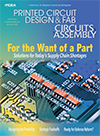Current Issue
Where excess inventory stops being clutter and starts being currency.
For years, companies have treated excess electronic components like an embarrassing secret. They get over-purchased, boxed up and quietly written off – destined for the trash, the gray market or whatever corner of the warehouse no one wants to inventory.
How do modern stencil materials and coatings influence transfer efficiency and volume repeatability as SMT features continue to shrink?
The key indicators of SMT stencil performance are transfer efficiency and volume repeatability. Transfer efficiency (TE) refers to the percentage of solder paste released from the stencil when compared to the stencil’s aperture volumes and is expressed as a percentage. Typical values range from 60% to 120%.
Just when the industry thought the shortage saga was over, the parts giant hit refresh on the chaos.
The global electronics industry faces another shortage situation. What began as a governance dispute between the Dutch government and the Chinese ownership of Nexperia has morphed into a geopolitical crisis with wide-ranging impacts on the printed circuit board assembly industry.


